Here is how to setup Japanese in Windows XP including handwritten kanji recognition.
Note that these instructions are for Windows XP Pro. I don't have XP Home. I assume it's the same but I could be wrong.
Installing Japanese Support
First go to the control panel and Pick "Date, Time, Language, and Regional Options"
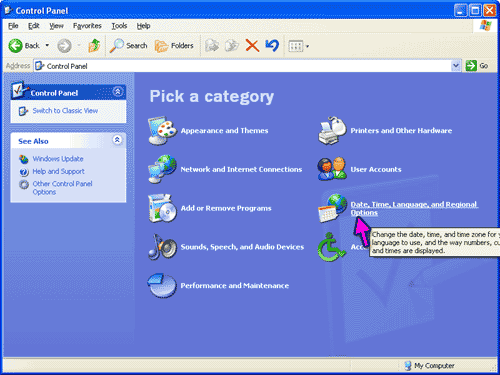
Then pick "Regional and Language Options"
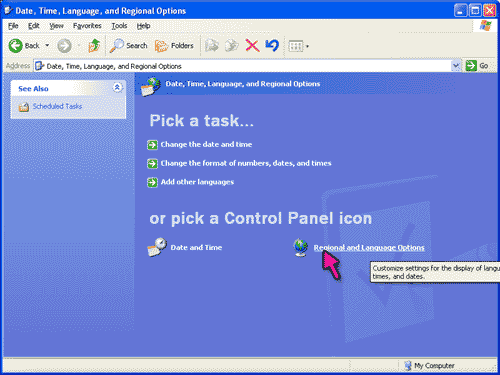
You should get the "Regional and Language Options" window like below. At the top click the "Languages" tab.
The first thing you need to do is click "Install files for East Asian Languages". Once you do that click "Apply".

Next click the "Advanced" tab and where it says "Code page conversion tables" you need to check "Japanese" and click "Apply". Until you do this Japanese will not be an option in certain places. I don't remember if you have to reboot at this point or not.
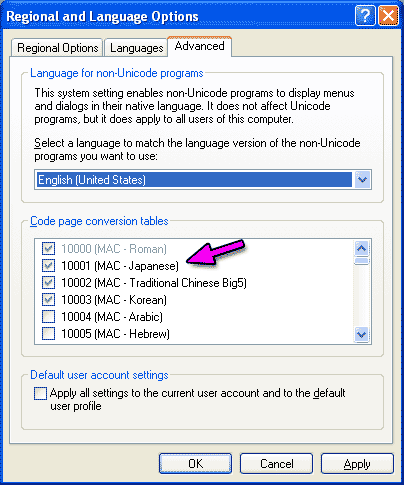
Anyway, the next step is to set Japanese for "Language for non−Unicode programs". This particular option will make it possible to run Japanese software as well as type Japanese almost anywhere including filenames, notepad, etc. Of course some programs don't support Japanese.
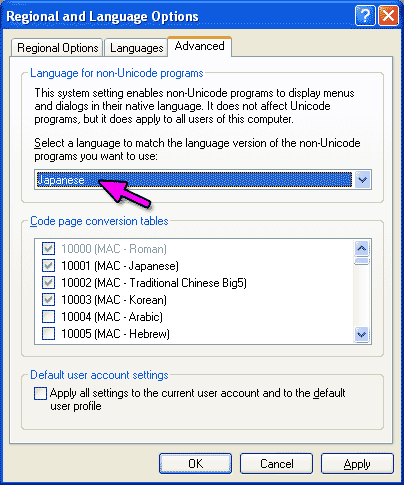
There are two problems with this setting though. One is aesthetic, the default system font becomes a font that supports Japanese and in non unicode Japanese the character / becomes ¥. That can be confusing since all paths almost anywhere in Windows will now have that symbol instead of . For example C:\windows\system32 becomes c:¥windows¥system32.
The second issue is that some programs look at this setting to decide what language to install in. Two that come to mind are Apple's Quicktime and Nero CD. In order to install them in English you need to set this setting back to English, reboot, install, set it back to Japanese, reboot.
After you are finished rebooting get back to the "Regional and Language Options" control panel, go back to the "Languages" tab and click "Details..." under "Text services and input languages".

That will bring up this window. Click "Add..."
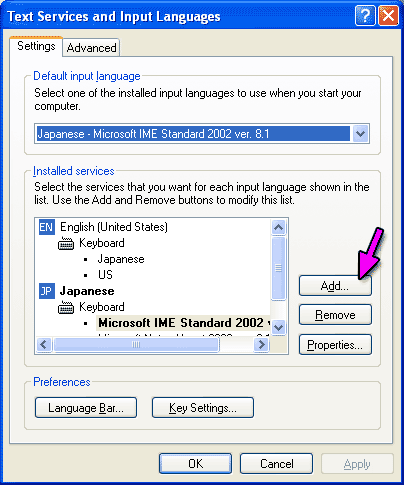
Set the input language to Japanese. For the keyboard layout I'm honestly not 100% sure since I have a Japanese keyboard so I can't check with an American one. For now set it to Japanese. FYI: A Japanese keyboard has 5−8 more keys than a US keyboard.
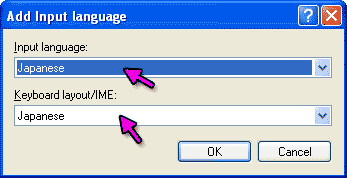
Click "OK" and now pick "Key Settings..."
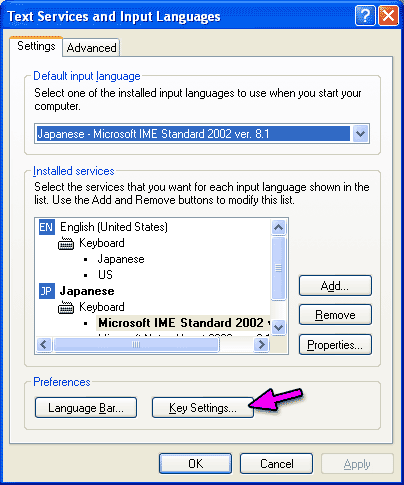
Select "Switch between input languages" and pick "Change Key Sequence..."
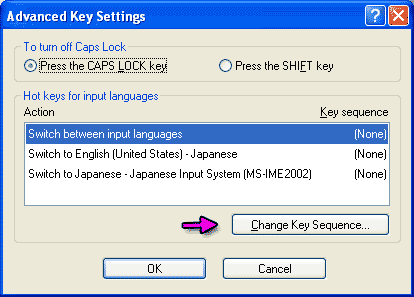
Turn OFF both "Switch input languages" and "Switch keyboard layouts". Normally pressing like Alt−Shift or something like that will switch between Japanese and English input. For me, I almost never want to switch (you can type English in Japanese input mode). Worse though it seems like I press those keys by accident quite often and it switches while I'm typing messing everything up so I suggest you turn this feature off.
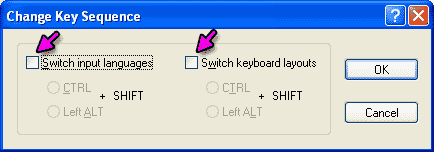
Click "Okay", "Okay", "Okay" until you are out of the control panels. You're done with the control panels.
Using the Japanese Input Method Editor (IME)
Now, most likely, somewhere on your screen you'll see a small window like this
![]()
That is called the "Language Bar" and it's where you can choose Japanese or English input modes. Click on "English" and you should be able to pick "Japanese"

The bar will change to this
![]()
I generally find that bar to be in the way so you can tell it to go into the taskbar. Right click it and pick "Minimize"
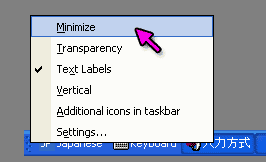
It should pop into the taskbar like this.
![]()
Although you shouldn't need to you can switch between Japanese and English input modes by clicking the JP/EN button.
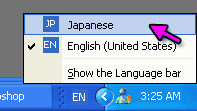
You can also pick "Show the Language bar" to get the big version back. Do that now.
Entering Japanese
Note that the language settings are PER PROGRAM!! That means if we were in English, ran two programs, in one program we went to the language bar and picked Japanese when we switched back to the other program it would still be in English input mode. This can be confusing. Another thing, unless some program is active that accepts text input some of the settings will not be available. So, open Notepad and keep it active while trying the follow stuff below.
Okay, the most basic thing you need to know. The 4th button in the language bar switches between several different sub input modes
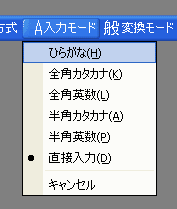
They are in order from top to bottom, Hiragana, Full Width Katakana, Full Width English, Half Width Katakana, Half Width English, Direct Input. The only 2 you really care about are Hiragana and Direct Input. Direct Input is English. You type, you get English just like Windows was before you did all this stuff. Set it to Hiragana and you can type romanji like "toru" and you'll see とる instead. The underline means the Input Method Editor (IME), the thing that does this is waiting for you to decide what you want to do with those characters. If you press ENTER they will be entered as is, If you press space once the IME will turn them into the most common thing they could be OR the last thing you told it to change them too. Press space again and you'll get a list of things it could be. For example on the second press I got this

The left window is a list of all the things the IME thinks it could change とる into. Use the cursor keys to select one. Generally the last thing on the list is katakana, in this case トル, that's why you never need to use the special Katakana input modes since you can just press space twice to get there. Also the list wraps so if you are at the top, press the up key and you'll go to the bottom. Plus, if you type something that would normally be katakana like てれび on the first space press it will become the most common thing which is テレビ.
On the right window are all the various homonym definitions for toru with examples. The first one for example is 取る as in to take a note, take a fee. The 3rd one is 撮る as in take a picture. Very useful, even many Japanese often forget which one is correct, especially the less common ones.
Once you have what you want press ENTER to complete it.
TIP: switching between Hiragana input mode and Direct Input mode through the language bar is tedious. Instead you can switch by pressing Alt-Tilde (the key below ESC on your keyboard). So, need to type Japanese, press Alt-Tilde, start typing. When you are done press Alt-Tilde again to switch back to English.
A more complex example.
Let's say you want to enter 今締める so you type いましめる. When you press space you'll get this 戒める. Pressing space again will not give you the completion you want. That's because the IME is trying to make a word out of all 5 characters. To tell it to use less hold shift and press the left arrow. Each time you do less of characters will be highlighted. Press it 3 times until you get this いましめる then press space again. This time the IME will only look up the first two characters. Most likely this time it will become this 今しめる. Notice the gap between 今 and しめる. This means the IME is considering those two words separately. Also the underline under 今 is thicker than the one under しめる indicating that 今 is the current thing the IME is concentrating on. To complete the second word press the right arrow. The underline under しめる will get thicker and you can press space to complete it and choose 締める.
English shortcut:
Sometimes you want to enter one English word in the middle of a Japanese sentence. Instead of switching to Direct Input mode you can just type and ignore what you see on the screen. For example type "handwritten" and you'll get "はんdwりってn" but then press F8 to convert it to half−width English and you'll get "handwritten". Keep pressing F8 and it will cycle through all uppercase, all lowercase, etc. Press F9 and you'll get full width English. Note that you can't press space since that would start completion so this is only useful for entering single words at a time.
Explanation:
In *normal* Japanese each character takes the same space. They are fixed size fonts. Check out any Japanese writing textbook and you'll see each character is supposed to fit into a box. For graphic design sometimes Japanese use proportional fonts but generally, much more than in English, lots of stuff is in a fixed size font.
Full Width means a character that fills one of those boxes. Half Width means a character that only fits half the box. Technically in the computer half width means it takes a single byte, full width means it takes more than one byte.
Full Width English ABC... not ASCII ABC, they are multi byte Japanese characters. Half Width English ABC... Normal ASCII English Full Width Katakana カタカナ double byte katakana characters Half Width Katakana カタカナ single byte katakana characters. The place this mostly comes up is on internet forms. Lots of forms will ask for your name in full width character then again in katakana in half-width. They'll ask for address in full width but postal code and phone number in half width.
Note: When typing in Hiragana mode pressing the space when there is nothing else typed will insert a full width space. That's usually what you want when typing Japanese but if you need a normal English space you can insert a half-width space while in Hiragana mode by pressing Shift-Space.
Handwritten kanji input
From the language bar click the 6th button (IME パッド). Up pops a list of other ways to enter stuff. The top one is handwriting.
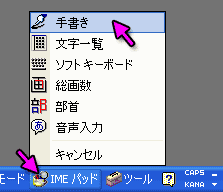
Once you pick it you'll get this window
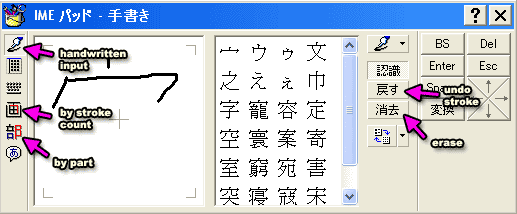
You can use your mouse or a pen if you have one to enter kanji. I've highlighted the most important buttons. The 2 on the right: "Undo stroke" backs up one stroke. "Erase" clears the writing area.
The ones on the left are just shortcuts for the options that were on the menu that brought you here. The most interesting are probably "by stroke count" which lets you lookup kanji by number of strokes and "by part" which lets you look them up by a particular part. They should be pretty obvious. In all of them the area on the right shows possible kanji. Click one to enter it in the IME. Press enter to add it to your document.
Again, it's important to remember these modes are PER PROGRAM. If you are in one program and select handwritten mode if you switch to a different program you will no longer be in handwritten mode.
Making Japanese your default
Hopefully from reading the above stuff and getting used to switching between Direct Input and Hiragana Input modes you'll realize you pretty much don't need English mode ever. If you navigate back into the "Regional and Language Options" −> "Languages" tab −> "Details..." you can set the "Default input language" to Japanese.
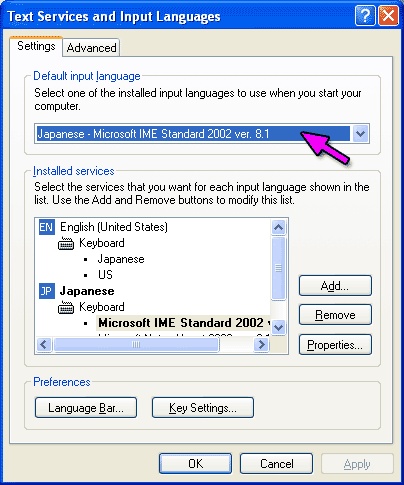
Now when you start Windows, Japanese will immediately be available.